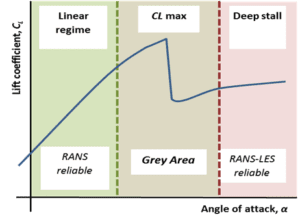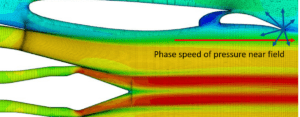Project Coordination
CFD-Berlin did coordinate and is coordinating – in some projects as the main coordinator – several international projects, amongst others:
DJINN
Decrease Jet Installation Noise
The ambition of the DJINN project is to develop a new generation of reliable computational fluid dynamics (CFD) methods, most of them belonging to the field of hybrid methods, for assessing promising noise-reduction technologies, with support and validation from reduced-scale experiments. This key ambition is tied to the provision of advanced tools for coupled aerodynamics-aeroacoustics to enable design optimisation in future industrial environments and to reach a new level of noise reduction through a highly collaborative effort.
The DJINN project denotes a breakthrough in designing quieter and greener aircraft through both improved CFD methods and better physical understanding.
Go4Hybrid
Grey Area Mitigation for Hybrid RANS-LES Methods (HRLM)
While HRLM have been proven to perform considerably better than conventional (U)RANS approaches in situations with strong or massive flow separation, they are hampered by the Grey Area issue once they have to deal with thin separation regions and where shear layer instabilities are weaker. As exactly these areas are of high importance for aircraft performance (lift, loads) the acceptance of HRLM strongly depends on the ability to mitigate the extent of the Grey Area (GA). With the new/advanced Grey Area mitigation approaches, the Go4Hybrid project offered hybrid RANS-LES methods that improve predictive capability with increased flexibility and reduced user decision load. The figure on the left hand side exhibits the area for an aircraft wing profile (max. lift) where the grey area plays a major role.
IMAGE
Innovative Methodologies and technologies for reducing Aircraft noise Generation and Emission
The objectives of IMAGE were innovative aircraft noise control/reduction technologies and strategies for effective suppression of airframe and engine noise generation and propagation, as well as improved computational and experimental methodologies. CFD-Berlin cooperated with the University of Kaiserslautern in optimizing the liner impedance for lowest possible noise emission. The numerical impedance boundary conditions were enhanced in cooperation with Beihang University in Beijing. One important outcome was a substantial improvement of the liner performance by axially segmenting the acoustic liners in the inlet of a fan. This was verified in experiments carried out by the Northwestern Polytechnical University (NPU) and the aircraft strength research institute (ASRI) in Xi’an, China.
 Helides
Helides
Helicopter Drag Prediction using Detached-Eddy Simulation
State-of-the art Detached-Eddy Simulation (DES) models were implemented in the open-source, unstructured CFD software OpenFOAM®. Simulations using Reynolds-averaged Naver Stokes (RANS) methids and unsteady RANS (URANS) methods were also conducted for comparison. URANS represents the current state-of-the-art in industrial practice. The results with DES agreed excellently with all available experimental data. The superiority of DES over (U)RANS was confirmed across all flow quantities and for all simulated configurations.
Jeronimo
JEt noise of high bypass RatiO eNgine: Installation, advanced Modelling and mitigatiOn
The central goal of JERONIMO is the understanding of the physical mechanisms of ultrahigh bypass ratio (UHBR) engines with a bypass ratio (BPR) larger than 12 and the related installed jet noise with potential jet-wing interaction. CFD-Berlin investigated the sound radiation of an isolated engine jet and two installed configurations numerically using a detached eddy simulation (DES) as simulation tool. The simulation results for the far-filed sound radiation agreed favourably with experimental results obtained in wind tunnels. The results revealed the physical mechanism of the added noise radiation, a condition for successful noise reducing designs.




